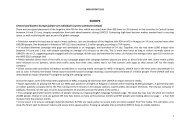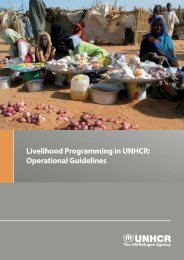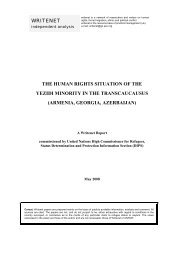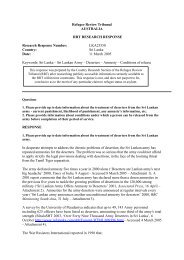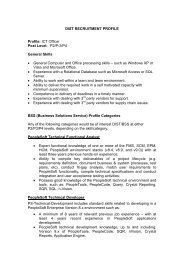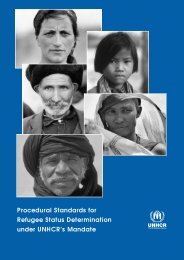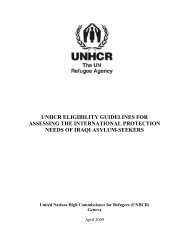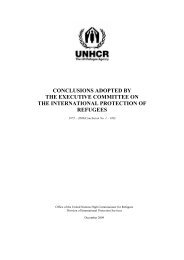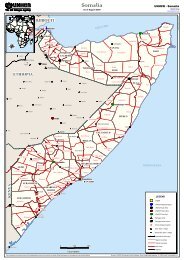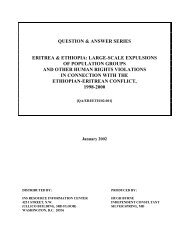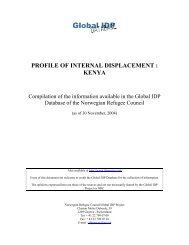UNHCR's ELIGIBILITY GUIDELINES FOR ASSESSING THE ...
UNHCR's ELIGIBILITY GUIDELINES FOR ASSESSING THE ...
UNHCR's ELIGIBILITY GUIDELINES FOR ASSESSING THE ...
Create successful ePaper yourself
Turn your PDF publications into a flip-book with our unique Google optimized e-Paper software.
V. <strong>ELIGIBILITY</strong> <strong>FOR</strong> INTERNATIONAL PROTECTION<br />
A. Overall Approach<br />
In view of the ongoing violence, conflict and human rights violations in Central and<br />
Southern Iraq, UNHCR considers Iraqi asylum-seekers from these areas to be in need of<br />
international protection. In those countries where the numbers of Iraqis are such that<br />
individual refugee status determination is not feasible, UNHCR encourages the adoption of<br />
a prima facie approach.<br />
In relation to countries which are signatory to the 1951 Convention relating to the Status of<br />
Refugees (“1951 Convention”) and/or its 1967 Protocol, and have in place procedures<br />
requiring refugee status determination under the Convention on an individual basis, Iraqi<br />
asylum-seekers from Central and Southern Iraq should be considered as refugees based on<br />
the 1951 Convention criteria, given the high prevalence of serious human rights violations<br />
related to one of the five grounds. Where, however, such asylum-seekers are not recognized<br />
under the 1951 Convention refugee criteria, international protection should be afforded<br />
through the application of an extended refugee definition, where this is available, 719 or<br />
otherwise through a complementary form of protection.<br />
International protection needs of asylum-seekers from the three Northern Governorates of<br />
Sulaymaniyah, Erbil and Dohuk should be individually assessed based on the 1951<br />
Convention refugee definition. In cases where an asylum-seeker is not recognized as<br />
a refugee under the 1951 Convention but nevertheless demonstrates protection needs for<br />
which complementary forms of protection may be appropriate, the case should be assessed<br />
accordingly. Taking into consideration the tenuous and unpredictable nature of the situation<br />
in the region and the possibility of sudden and dramatic change, the approach outlined in<br />
719 See Article 1 of the Convention Governing the Specific Aspects of Refugee Problems in Africa (“OAU<br />
Convention”), 10 September 1969, available in UNHCR’s Refworld at: http://www.unhcr.org/cgi-bin/texis/<br />
vtx/refworld/rwmain?docid=3ae6b36018:<br />
“1. For the purposes of this Convention, the term “refugee” shall mean every person who, owing to well-founded fear<br />
of being persecuted for reasons of race, religion, nationality, membership of a particular social group or political<br />
opinion, is outside the country of his nationality and is unable or, owing to such fear, is unwilling to avail himself of<br />
the protection of that country, or who, not having a nationality and being outside the country of his former habitual<br />
residence as a result of such events is unable or, owing to such fear, is unwilling to return to it.<br />
2. The term “refugee” shall also apply to every person who, owing to external aggression, occupation, foreign<br />
domination or events seriously disturbing public order in either part or the whole of his country of origin or<br />
nationality, is compelled to leave his place of habitual residence in order to seek refuge in another place outside his<br />
country of origin or nationality.”<br />
and Section III para. 3 of the Cartagena Declaration on Refugees, 22 November 1984, available in UNHCR’s<br />
Refworld at: http://www.unhcr.org/cgi-bin/texis/vtx/refworld/rwmain?docid=3ae6b36ec:<br />
“To reiterate that, in view of the experience gained from the massive flows of refugees in the Central American area,<br />
it is necessary to consider enlarging the concept of a refugee, bearing in mind, as far as appropriate and in the light<br />
of the situation prevailing in the region, the precedent of the OAU Convention (article 1, paragraph 2) and the<br />
doctrine employed in the reports of the Inter-American Commission on Human Rights. Hence the definition or concept<br />
of a refugee to be recommended for use in the region is one which, in addition to containing the elements of the 1951<br />
Convention and the 1967 Protocol, includes among refugees persons who have fled their country because their lives,<br />
safety or freedom have been threatened by generalized violence, foreign aggression, internal conflicts, massive<br />
violation of human rights or other circumstances which have seriously disturbed public order.”<br />
131




